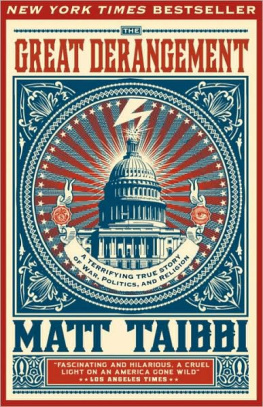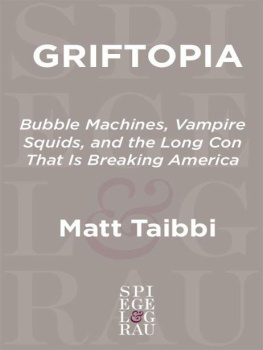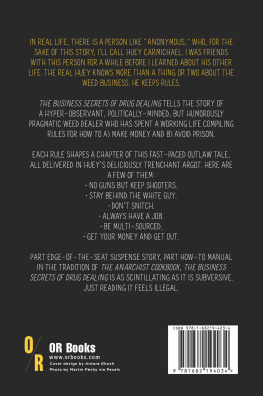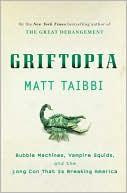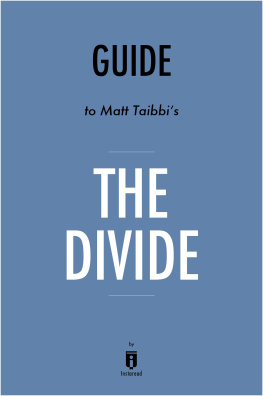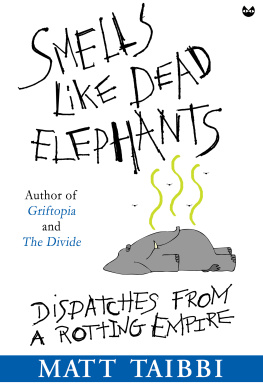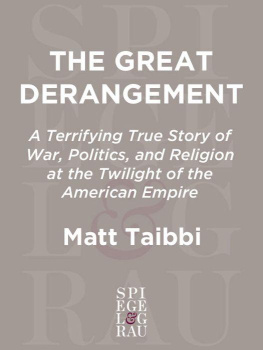

This is a work of nonfiction. Some names and identifying details have been changed.
Copyright 2014 by Matt Taibbi
Illustrations copyright 2014 by Molly Crabapple All rights reserved.
Published in the United States by Spiegel & Grau, an imprint of Random House, a division of Random House LLC, a Penguin Random House Company, New York.
S PIEGEL & G RAU and the H OUSE colophon are registered trademarks of Random House LLC.
Library of Congress Cataloging-in-Publication Data
Taibbi, Matt.
The divide : American injustice in the age of the wealth gap / Matt Taibbi.
pages cm
ISBN 978-0-8129-9342-4
eBook ISBN 978-0-67964546-7
1. Social justiceUnited States. 2. Income distributionUnited States. 3. Rich
peopleUnited States. 4. PoorUnited States. I. Title.
HM671.T35 2014
303.372dc23
2013024907
www.spiegelandgrau.com
Jacket art direction: Greg Mollica
Jacket illustration: Molly Crabapple
Jacket design: Thomas Ng
v3.1
Fairness is what justice really is.Potter Stewart



Over the course of the last twenty years or so, America has been falling deeper and deeper into a bizarre statistical mystery.
Take in the following three pieces of information, and see if you can make them fit together.
First, violent crime has been dropping precipitously for nearly two decades. At its peak in 1991, according to FBI data, there were 758 violent crimes per 100,000 people. By 2010 that number had plunged to 425 crimes per 100,000, a drop of more than 44 percent.
The decrease covered all varieties of serious crime, from murder to assault to rape to armed robbery. The graphs depicting the decline show a long, steady downswing, one that doesnt jump from year to year but consistently slumps from year to year.
Second: although poverty rates largely declined during the 1990s, offering at least one possible explanation for the drop in violent crime, poverty rates rose sharply during the 2000s. At the start of that decade, poverty levels hovered just above 10 percent. By 2008 they were up to 13.2 percent. By 2009 the number was 14.3 percent. By 2010, 15.3 percent.
All this squares with what most people who lived in Middle America knew, and know, instinctively. Despite what were being told about a post-2008 recovery, despite what the rising stock market seems to indicate, the economy is mostly worse, real incomes are mostly declining, and money is mostly scarcer.
But throughout all this time, violent crime has gone down. It continues to decline today. Counterintuitively, more poverty has not created more crime.
The third piece of information that makes no sense is that during this same period of time, the prison population in America has exploded. In 1991 there were about one million Americans behind bars. By 2012 the number was over 2.2 million, a more than 100 percent increase.
Our prison population, in fact, is now the biggest in the history of human civilization. There are more people in the United States either on parole or in jail today (around 6 million total) than there ever were at any time in Stalins gulags. For what its worth, there are also more black men in jail right now than there were in slavery at its peak.
See if this syllogism works, then.
Poverty goes up;Crime goes down;Prison population doubles.
It doesnt fit, unless some sort of alternative explanation comes into play. Maybe all those new nonviolent prisoners fit into some new national policy imperative. Maybe they all broke some new set of unwritten societal rules. But what?
While on a visit to San Diego to do research for this book, I heard a crazy story.
The subject was the citys P100 program, under which anyone who applied for welfare could have his or her home searched preemptively by the state. Ostensibly, authorities were looking for evidence that the applicant had a secret job or a boyfriend who could pay bills, or was just generally lying about something in order to cheat the taxpayer out of that miserable few hundred bucks a month.
One Vietnamese woman, a refugee and a rape victim who had only recently come to America, applied for welfare in San Diego. An inspector came to her door, barged in, and began rifling through her belongings. At one point, he reached into her underwear drawer and began sifting around. Sneering, he used the tip of the pencil eraser to pull out a pair of sexy panties and looked at her accusingly. If she didnt have a boyfriend, what did she need these for?
That image, of a welfare inspector sneeringly holding up panties with a pencil end, expresses all sorts of things at once. The main thing is contempt. The implication is that someone broke enough to ask the taxpayer for a handout shouldnt have sex , much less sexy panties.
The other thing here is an idea that being that poor means you should naturally give up any ideas you might have about privacy or dignity. The welfare applicant is less of a person for being financially dependent (and a generally unwelcome immigrant from a poor country to boot), so she naturally has fewer rights.
No matter how offensive the image is, it has a weird logic thats irresistible to many if not most Americans. Even if we dont agree with it, we all get it.
And thats the interesting part, the part where we all get it. More and more often, we all make silent calculations about who is entitled to what rights, and who is not. Its not as simple as saying everyone is the same under the law anymore. We all know theres another layer to it now.
As a very young man, I studied the Russian language in Leningrad, in the waning days of the Soviet empire. One of the first things I noticed about that dysfunctional wreck of a lunatic country was that it had two sets of laws, one written and one unwritten. The written laws were meaningless, unless you violated one of the unwritten laws, at which point they became all-important.
So, for instance, possessing dollars or any kind of hard currency was technically forbidden, yet I never met a Soviet citizen who didnt have them. The state just happened to be very selective about enforcing its anticommerce laws. So the teenage farsovshik (black market trader) who sold rabbit hats in exchange for blue jeans outside my dorm could be arrested for having three dollars in his pocket, but a city official could openly walk down Nevsky Avenue with a brand-new Savile Row suit on his back, and nothing would happen.
Everyone understood this hypocrisy implicitly, almost at a cellular level, far beneath thought. For a Russian in Soviet times, navigating every moment of citizenship involved countless silent calculations of this type. But the instant people were permitted to think about all this and question the unwritten rules out loud, it was like the whole country woke up from a dream, and the system fell apart in a matter of months. That happened before my eyes in 1990 and 1991, and I never forgot it.
Now I feel like Im living that process in reverse, watching my own country fall into a delusion in the same way the Soviets once woke up from one. People are beginning to become disturbingly comfortable with a kind of official hypocrisy. Bizarrely, for instance, weve become numb to the idea that rights arent absolute but are enjoyed on a kind of sliding scale.
Next page

